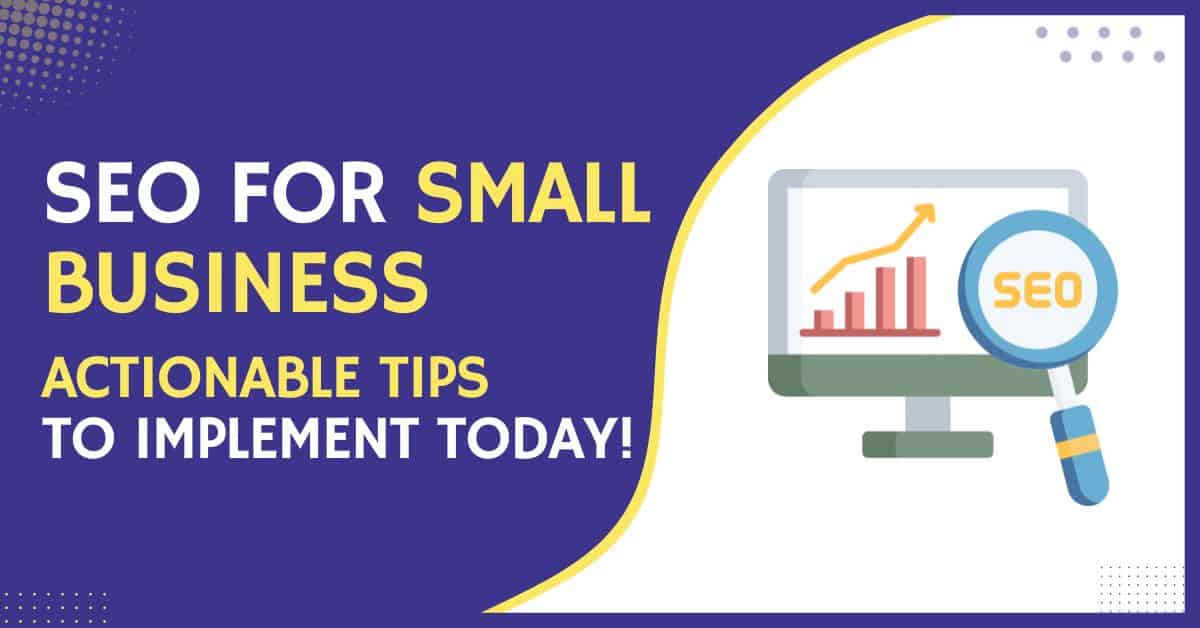Without proper SEO, your business is essentially invisible to search engines, especially for smaller businesses with limited budgets and resources. This means missed opportunities, lower search traffic, and ultimately, lost revenue.
But it doesn’t have to be this way.
With the right SEO strategies, even small businesses can improve their rankings on Google and reach their potential customers.
In this guide, I’ll reveal 11 actionable SEO strategies for small businesses. By the end, you’ll know exactly how to boost your website’s visibility in search results and attract more customers–all without breaking the bank.
So, let’s get started!
- What is Small business SEO?
- Why is SEO important for small businesses?
- 15 SEO Tips For Small Businesses To Stay Competitive in 2024
- 1. Claim and optimize your Google Business Profile
- 2. Set Up Google Analytics and Google Search Console
- 3. Create Content clusters
- 4. Don't ignore on-page SEO
- 5. Create content that directly speaks to your customers.
- 6. Build backlinks–Only need a few
- 7. Fix any technical errors
- 8. Optimize for mobile devices
- 9. Add structured data
- 10. Optimize for Voice Search
- 11. Encourage & respond to reviews.
- Small business SEO vs Local SEO
- Start Implementing These SEO Strategies & Grow Your Online Presence
- FAQs
What is Small business SEO?
Small Business SEO is the process of improving a small company’s website to rank higher in search engine results (SERPs). This helps potential customers find your business more easily. It generally focuses on queries relevant to the company’s products, services, or local market.

What sets it apart from general SEO is that it is more targeted to certain products or services and often has limited resources. And if you’re a small business with a physical store, a priority on local search results, too.
Simply put, Small Business SEO means tailoring SEO strategies to fit the unique needs, budget constraints, and local focus of smaller enterprises.
Why is SEO important for small businesses?
Search Engine Optimization (SEO) is important for small businesses because it helps you- as a small business owner- rank higher in search engine results pages and increase your online visibility. This means more leads, sales, and business growth.
Other benefits of seo for small businesses are:
- Targeted traffic to your website: Most likely to attract people actively searching for your products/services.
- Cost-effective marketing: Once your website ranks well for relevant keywords, it can continue to drive traffic without ongoing ad spend.
- Increased Credibility and Trust: It makes your business look reliable & trustworthy.
- Competitive edge: It help small businesses to compete with larger companies online.
- Local customer acquisition: Excellent for attracting nearby customers/foot traffic for those with a physical store.
- 24/7 promotion: It keeps bringing in potential clients day and night.
15 SEO Tips For Small Businesses To Stay Competitive in 2024
1. Claim and optimize your Google Business Profile
Did you know Google Business Profile is one of the critical Google ranking factors for local searches?
As a small business owner, the first thing you need to do is claim your Google Business Profile account. It is a free platform offered by Google for small businesses with a physical location, but other online businesses or services can also claim it.
GMB helps people find and learn about your business on Google local searches, Google Maps, and Google Shopping.
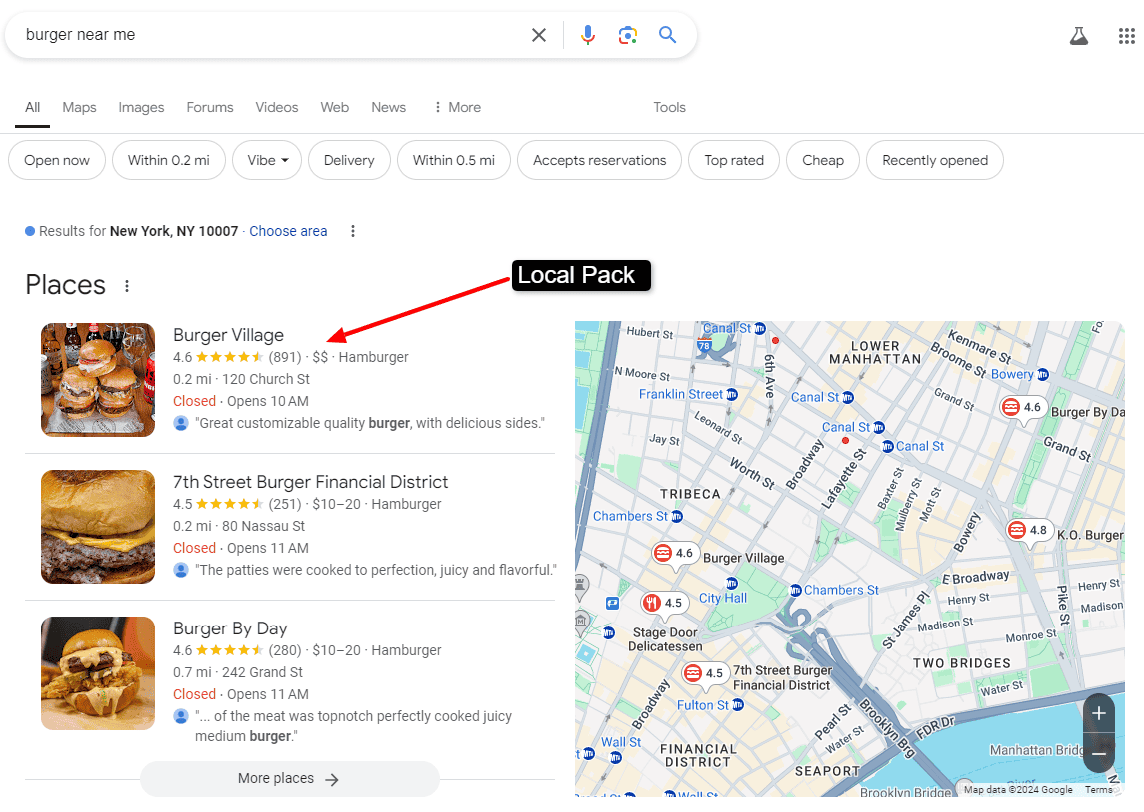
You can add all your business details here, such as your phone number, business address, availability times, offerings, and more. You can even post updates about your business, events you are having, or any other programs related to your business.
With GMB, it is easy to communicate with your customers. You can even manage your reviews from here and respond to them. Plus, you also get access to analytics and customer insights, which is very valuable for understanding your customers and adjusting your strategies.
2. Set Up Google Analytics and Google Search Console
After setting up your website on WordPress, the first thing you need to do is set up Google Analytics and Google Search Console and connect them to your website. Offered by Google for free, both are essential SEO tools to measure and track your SEO performance.
Google Analytics basically tracks and reports on user or “website traffic.” It provides website owners with detailed traffic insights such as the number of visitors, their geographic area, which pages they visit, bounce rates, conversation rates, etc.

Google Search Console, on the other hand, provides detailed reports on website performance on search engines. You can analyze metrics like your average ranking position, average CTR, top-ranking keywords, impressions, etc. You can also submit your sitemaps and find any indexing errors on your website from GSC.
3. Create Content clusters
Writing one article in a single keyword and expecting to rank while not covering any of its semantically related topics/keywords may disappoint you in 2024.
With competition being fierce, it is very critical to cover all the relevant topics/keywords related to the main keyword to show Google that you are an authority on that topic. Especially for smaller businesses as they already have low authority when starting.
For e.g., if you want to rank for “best mushroom coffee,” you also need to cover its other semantically relevant topics like:
- Is mushroom coffee good for you?
- Mushroom coffee benefits
- Is mushroom coffee healthy?
- Mushroom coffee side effects
- Does mushroom coffee help you lose weight?
Also, with Google emphasizing E-E-A-T more, covering a topic comprehensively has become more important than ever.
Why bother with content clusters?
- It helps Google understand your website structure.
- It shows you’re an authority on a topic.
- It improves your internal linking (which search engines love).
- It gives your visitors a better experience.
4. Don’t ignore on-page SEO
With SEO being more advanced, you may think:
- Is on-page SEO still necessary?
- Do people still optimize on-page elements?
The answer is Yes. In fact, it is one of the most critical ranking factors to date. Google still expects keyword placement in SEO title tags, URLs, and Page titles.
Google uses them to find out what the page is about. The other crucial areas to insert keywords or at least their variation would be subheadings, intro, and body contents.
However, changing only these can’t bump you on the first page as things are very competitive nowadays. You will need to do a lot of other things to get to the top but why leave room for improvement when you can easily optimize these fundamental elements?
Other essential on-page best practices include:
- Keep your title short–under 60 characters.
- Keep your URLs concise.
- Use a keyword or its variation in the meta description as it greatly influences CTR–keep it under 160 characters.
- Keep your subheading structure flow nice. Do not jump from H2 to H4. It should always be in this order: H1>H2>H3>H4>H5>H6.
- Use only one H1 per page, i.e., “Page Title.”
- Use descriptive file names for images and add alt text to describe the image (also include keywords if relevant)
5. Create content that directly speaks to your customers.
Whatever you do, if your content does not resonate with your potential customer’s interest, you’ll struggle to convert visitors into customers. Even if you rank, people will leave your site instantly and you will have a high bounce rate which is not good for SEO.
So, what does “create content that directly speaks to your customers” mean?
It means you are directly addressing your customer’s needs, questions, and pain points in your articles and offering solutions. No fluff, no nonsense–giving exactly what readers are looking for.
It should be well-researched, original, and written in a clear, easy-to-understand manner using language and tone that resonates with them.
How do you create content that directly speaks to your customers?
- Know your target audience: Research and develop detailed buyer personas. Understand their demographics, challenges, goals, and preferences.
- Match the search intent: Ensure your content aligns with what users are actually seeking when they search for related topics. This could be information, comparisons, or direct solutions, depending on their stage in the customer journey.
- Address pain points: Identify and focus on solving your customers’ specific problems or needs.
- Provide value: Offer practical, actionable advice or insights they can apply immediately.
- Be conversational: Write in a natural, friendly tone as if you’re speaking directly to the reader.
- Ask questions: Engage your audience by posing questions they might ask themselves.
- Use “you” and “your”: Address the reader directly to make the content feel more personal.
- Showcase benefits: Emphasize how your product or service improves their lives, not just its features.
6. Build backlinks–Only need a few
Backlinks are a well-known ranking factor and for a good reason. High-quality backlinks from authoritative websites can significantly boost your site’s visibility and ranking in Google search results – the more, the better.
But you, as a small business owner, don’t need much. Only a few relevant links from reputable sites can be enough to bump your site to the top of the search engine result pages.
Here are some ideas you can try:
1. Get listed on relevant online directories: As a small business owner, the first thing to do for links is to get listed on various online directories relevant to your business. These are simple and easy to get links. Find relevant directories and submit your website along with other business information and you are done.
But make sure to insert your business information correctly because these directory sites rank on Google. And if your information is incorrect, it can hurt your rankings and business.
Some directory sites you can get started with:
- Yelp
- Yellowpages
- Apple maps
- Bing Places for Business
2. Replicate competitor’s backlinks: Besides directory listings, the best links you can build are links that your competitors have. They are working for your competitors; they will work for your site, too. And you know these sites are open to linking to businesses like yours as your competitors already have them.
To find these links, plug one of your competitors into “Semrush backlink analytics tools” and go to the “backlinks” section. And there you have all the backlinks that your competitors have.
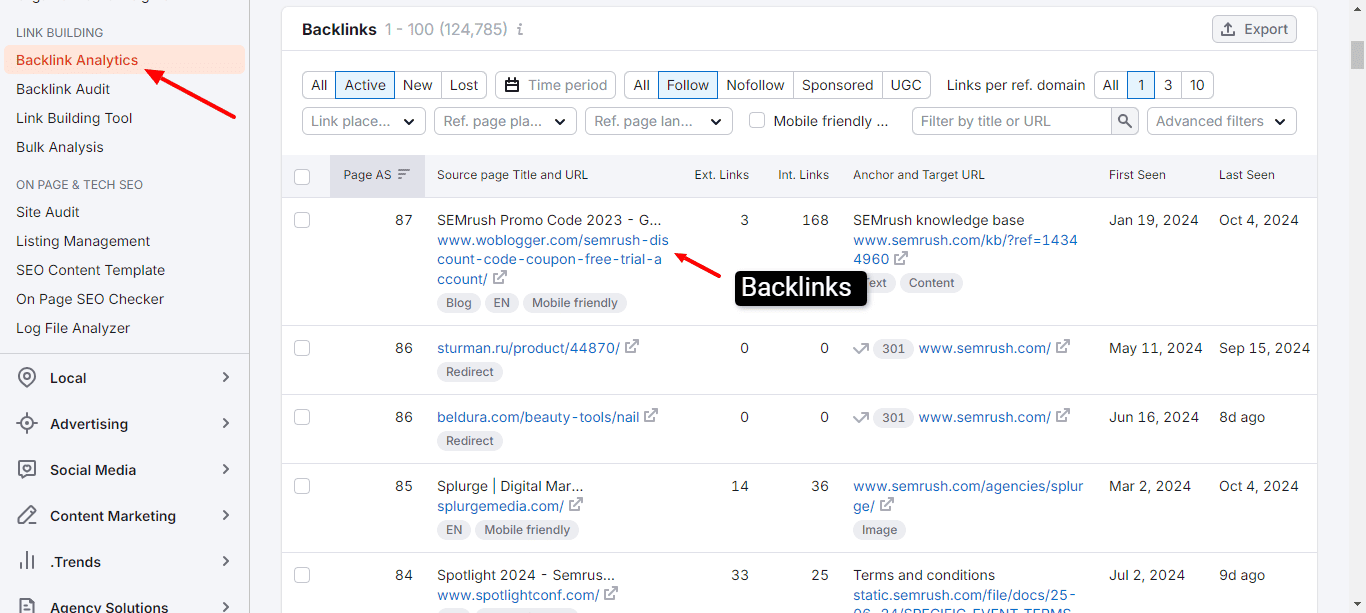
Most importantly, identify the type of content that earned these links – whether it’s guest posts, interviews, or resource mentions. Then, create your own similar but superior content and reach out to those webmasters with a personalized approach, offering your content as a valuable resource.
3. Ask your supplier or business partners: Asking to your suppliers or business partners to link to your website can be an excellent way to build your link profile. This should not be hard, considering you already have a good relationship with them and are more likely to consider your request. They might link to you as:
- A trusted customer or client
- A recommended service provider
- A collaborator on projects
- Part of their supply chain
When asking for links, you could:
- Offer to provide a testimonial in exchange for a link
- Suggest a mutual linking arrangement if appropriate
- Propose featuring each other in case studies or success stories
This way, it’s a win-win for both of you.
7. Fix any technical errors
Technical errors can significantly hinder your website’s performance in search rankings, regardless of how good your content is.
Fixing any technical errors should be a top priority for any business with a website so that your other SEO efforts can reach their full potential and not be hindered by underlying issues. When your website is technically sound, search engines can easily crawl, index, and understand your content, allowing your other SEO strategies to shine.
Common technical SEO issues to watch out for are:
- Slow loading speed
- Broken links
- Duplicate content
- XML sitemap errors
- Robots.txt file errors
- Security issues
To find and fix these, just head over to the Semrush site audit tool. Insert your domain and click “start audit”. It may take some time depending on the size of your website.
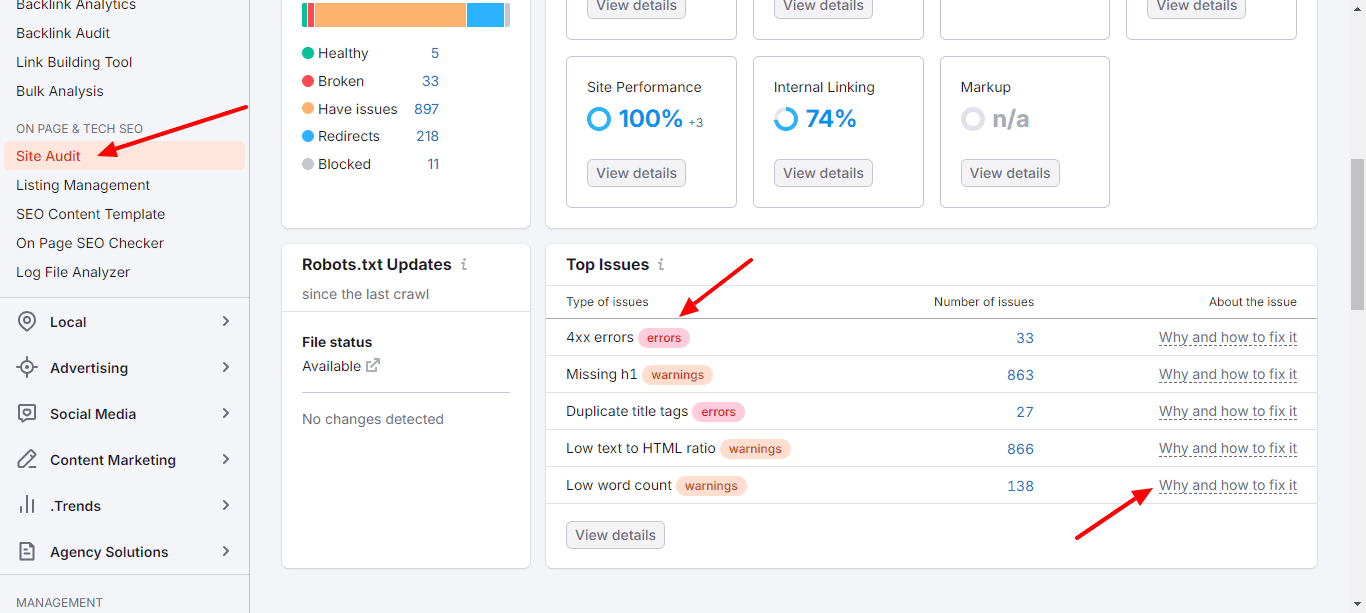
Click on the specific errors to find out more and also get suggestions on how to fix them. Deal with them one by one, and it’s okay to call for help if you can’t fix them all.
You can also use PageSpeed Insights if you don’t have a Semrush subscription. It’s free.
8. Optimize for mobile devices
Approximately 59% of all web traffic now comes from mobile devices, and this figure is expected to rise to 72% by 2025. It clearly shows that most of our potential customers are using smartphones or tablets to find businesses online.
Seeing this increasing mobile usage, Google now uses mobile-first indexing, which means it primarily uses the mobile version of your site for ranking and indexing. If your site is not mobile-friendly, Google may not even consider your site.
Thus, optimizing for mobile devices is not optional anymore; it’s a compulsion for all website owners.
To optimize for mobile:
- Use responsive themes/design
- Improve page load times
- Ensure text is readable without zooming
- Make buttons and links easy to tap
- Use structured data for better mobile display in search results
9. Add structured data
Structured data is standardized code that helps search engines understand the context and relationship of the content on your site. It provides additional information about your business, such as location, services offered, and reviews.
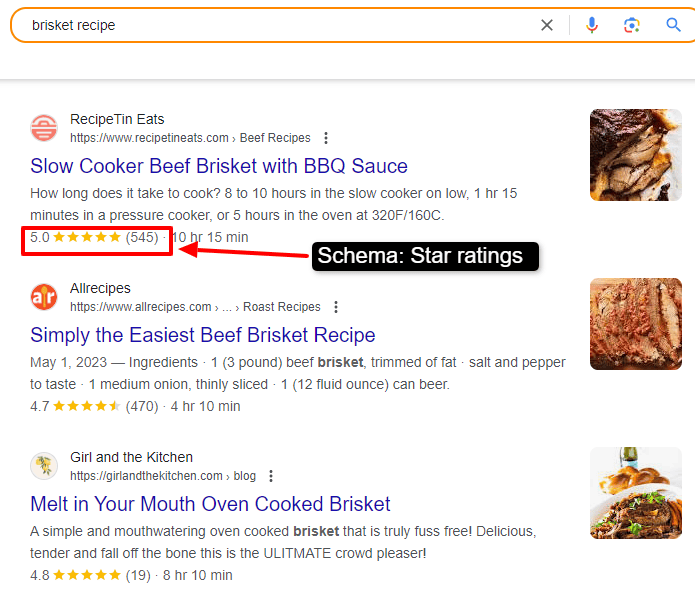
Why should you care?
For companies, implementing structured data can lead to rich snippets in search results, such as star ratings, product prices, or event dates, making your listings more eye-catching and informative. This can significantly improve your click-through rates, even if you’re not in the top position.
To get started:
- Choose your schema: Schema.org is the most common vocabulary for structured data. They have schemas for all sorts of content – products, recipes, events, you name it.
- Implement the code: You can add structured data directly to your HTML or use Google’s Structured Data Markup Helper.
- Test it: Use Google’s Rich Results Test to make sure you’ve implemented it correctly.
- Monitor results: Keep an eye on your Search Console to see how your rich results are performing.
Remember, structured data doesn’t guarantee rich snippets, but it does increase your chances. And even if you don’t get the fancy display, it still helps Google understand your content better.
10. Optimize for Voice Search
“Hey Siri, find me the best pizza place nearby.”
Sound familiar?
Optimizing for voice search is becoming increasingly important for small businesses as more people use voice assistants like Siri, Alexa, and Google Assistant.
In fact, a study shows that 46% of people use voice search to find local businesses on a daily basis. If you’re not optimizing your website for voice search, you are missing out on a whole lot of potential customers, especially if you are a business with a physical address.
Few tips to optimize for voice search:
Voice searches are different from typed searches. They’re usually longer, more conversational, and often in the form of questions.
- Focus on long-tail keywords: Voice searchers use natural language. “Pizza place near me” becomes “What’s the best pizza place open now near me?”
- Use question phrases: Think about the questions your customers might ask and include those in your content.
- Optimize for local searches: Many voice searches are looking for local info. Make sure your Google My Business listing is up to date.
- Aim for featured snippets: Voice assistants often pull from these for their answers.
- Improve page speed: Voice search users want quick answers. A fast-loading site helps.
- Use natural language: Write in a conversational tone. This is good for voice search and for your human readers, too!
- Think mobile: Most voice searches happen on mobile devices. Make sure your site is mobile-friendly.
11. Encourage & respond to reviews.
Did you know reviews are one of the top-ranking factors for local search results?
Yes, reviews can greatly influence your Google ranking and your trust in potential customers. Positive reviews can also boost your local SEO, making your business more visible in local search results and Google Maps.
Google itself suggests encouraging your customers to leave a review and reply to all.

Image via Google
To ask for reviews, simply share your GMB link to your customers in your thank you emails, at the end of a chat interaction, or on your receipts.
To leverage reviews for your small business SEO:
- Make it easy for customers to leave reviews
- Respond promptly and professionally to all reviews
- Address negative reviews constructively
- Share positive reviews on your website and social media
- Use review insights to improve your business and SEO strategy
Tip: Authentic reviews and genuine responses are key regardless of positive or negative. In fact, according to Google, customers find a mix of positive and negative reviews more trustworthy. So avoid buying fake reviews, as this can severely penalize your SEO efforts.
Small business SEO vs Local SEO
Small business SEO and local SEO – aren’t they the same thing?
Well, not quite. They’re like cousins – related but with their own unique traits.
Small Business SEO is about optimizing your online presence to attract customers, regardless of location. It focuses on targeting a broader audience, potentially nationwide or globally and aims to rank in global organic search results.
Local SEO, on the other hand, is all about attracting nearby customers or, say, “local customers“. It emphasizes on location-based keywords (e.g., “near me,” city names) and aims to appear in local pack results and Google Maps.
Start Implementing These SEO Strategies & Grow Your Online Presence
Finally, we have come to the last. I have included all the SEO tips that I think are necessary to improve your rankings and get to the top of search result pages.
But don’t worry – you don’t have to tackle all these SEO best practices at once. Start with the tactics you’re most comfortable with and gradually incorporate the others as we move forward.
Most importantly, don’t expect the results instantly. SEO is an ongoing process, not a one-time fix.
Put these search engine optimization tips into action on your website and watch your small business grow online!
FAQs
Is SEO worth it for a small business?
Yes, SEO can be valuable for small businesses. It helps improve your small business’s online visibility, attract local customers, and compete with larger companies cost-effectively.
Related: Is SEO worth it for small business in 2024? The Ultimate Truth!
Does having Google my business help SEO?
Yes, Google My Business positively impacts local SEO. It improves local search visibility, provides essential business information to potential customers, and can boost your ranking in Google Maps and local search results.

Rabin is an SEO Specialist and a content creator who is also a BCA graduate. He shares easy-to-follow hacks and tips to help you make smart choices for SEO tools and strategies through his blog. Passionate about learning and sharing, Rabin’s goal is to help you navigate your SEO and blogging journey with confidence.

